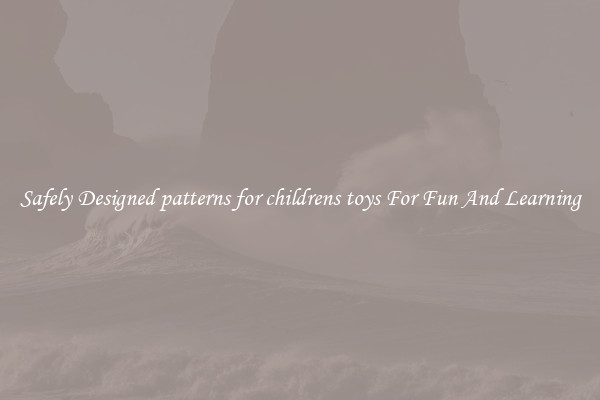Safely Designed patterns for childrens toys For Fun And Learning
Safely Designed Patterns for Children's Toys: For Fun and Learning

Children's toys come in all shapes and sizes, with various designs and patterns that attract and engage little ones. While we may be drawn to vibrant colors and intricate details, it is crucial to prioritize safety when choosing toys for children. Safely designed patterns not only ensure a hazard-free play environment but also contribute to the overall fun and learning experience for children.
First and foremost, when considering patterns for children's toys, it is essential to opt for non-toxic materials. Many toys market themselves as being safe for children, but it is crucial to double-check and ensure they pass safety standards by regulatory bodies. Non-toxic patterns are critical, especially for toys that babies or young children might put in their mouths, as young children explore their surroundings by touch and taste.
Patterns that are easy to clean and maintain are also important for children's toys. Let's face it, children can get messy while playing, and toys can easily become dirty or even carry germs. Choosing toys with washable, wipeable, or easily removable patterns will help keep them clean and prevent the accumulation of dirt and bacteria. Moreover, toys with vibrant patterns that do not fade or wear off easily can maintain their visual appeal for a longer time.
Another aspect to consider when it comes to safely designed patterns is the size and shape of the toy's parts. Toys with small parts can be a choking hazard for young children who have a tendency to put things in their mouths. It is essential to ensure that patterns do not include detachable or easily breakable parts that could potentially harm children. Clear labeling indicating age appropriateness can also help parents and caregivers make informed decisions about toy purchases.
Patterns that encourage imagination and learning are highly beneficial for children's toys. Toys that incorporate puzzles, numbers, letters, or even different textures help promote cognitive development and create a stimulating play experience. Bright colors and contrasting patterns can enhance visual perception and recognition for young children. Additionally, patterns that involve different shapes and textures can assist in developing fine motor skills and hand-eye coordination.
Lastly, patterns that reflect inclusivity and diversity are vital for children's toys. By including a range of ethnicities, genders, abilities, and cultures in toy patterns, children can learn about and appreciate diversity from a young age. Inclusivity in patterns can help foster empathy, understanding, and acceptance among children, promoting a positive and inclusive play environment.
In conclusion, safely designed patterns play a crucial role in children's toys. When selecting toys, it is essential to consider patterns that are non-toxic, easy to clean, and age-appropriate. Patterns that encourage learning and imagination, as well as promote inclusivity and diversity, create an engaging and safe play environment for children. By prioritizing safety in toy patterns, we can ensure that children can have fun and learn while playing with their favorite toys.

View details

View details

View details

View details








